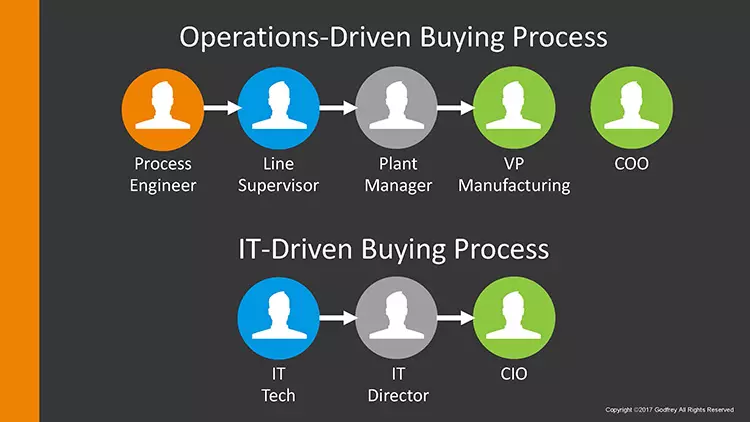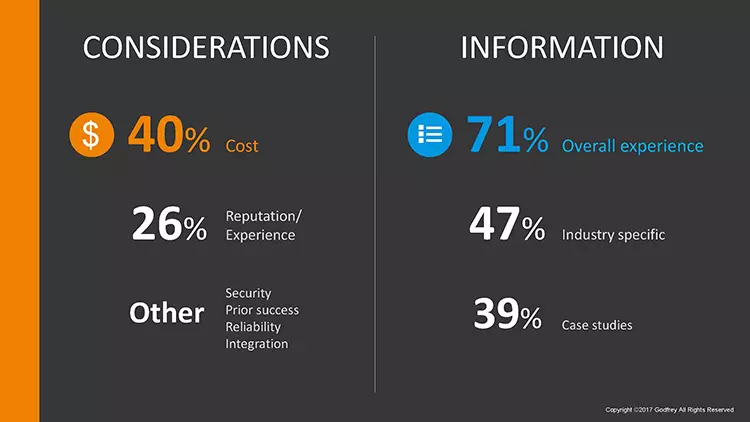How the Industrial Internet of Things Will Impact B2B Marketing

The Industrial Internet of Things changes B2B marketing significantly by giving IT decision-makers a lot of clout in the manufacturing buying process.
As a B2B marketing agency deeply immersed in the manufacturing sector, Godfrey has been following Industry 4.0 and the related Internet of Things for some time.
As a matter of fact, I wrote a blog post entitled, “The Rise of the Manufacturing CIO in Marketing” last December. It outlined the emerging role of Information Technology roles, and the Chief Information Officer (CIO), in the industrial buying process.
Godfrey partnered with AMG Research to study an emerging segment of your audience. Download the full report and view slides from the presentation we delivered at CFE Media’s 2017 Marketing to Engineers® event.
But we wanted to know more about this new enterprise connectivity, which is known by a variety of terms, including the Industrial Internet of Things and Industry 4.0.
So in January, Godfrey partnered with AMG Research to learn more about how all of this would impact B2B marketing.
We presented the results of that research at CFE Media’s Marketing to Engineers event earlier this month. You can download our presentation or a full copy of the report.
Perhaps the most important finding was that, in fact, the B2B industrial buying process is changing. Here’s how:
Key Insight No. 1: New players totally disrupt the old dynamics
There are new players entering the B2B buying process. Even more significantly, they are entering in an unprecedented way.
In the past, when the buying team expanded, it usually involved adding new influencers and maybe a few recommenders. Almost as an afterthought.
For example, a representative from maintenance might be added to a group considering purchase of a new line of equipment, to make sure ongoing maintenance requirements are considered. Experts from Environmental Health and Safety may be added to review environmental impact and/or liability concerns, etc., or purchasing people may be added to negotiate contract details.

The key point: They came in as an influencer. But not a decision-maker.
Our research found, however, that decision-makers from Information Technology are being added to B2B buying teams, but in a totally different way: They are bringing both money and authority.
In effect, they are the funding source, especially for projects that involve the kind of enterprise-wide connectivity represented by the Industrial Internet of Things.
And with the money, comes the clout. Our study found that IT staff is the dominant player at all three stages of the buying cycle. They are much more likely than other titles to initiate, advocate for and approve high-level IIOT/Industry 4.0 projects.
Key Insight No. 2: New players differ significantly from your traditional buyers
These new IT buyers behave much differently than the traditional audience for an industrial product, who usually are engineers:
- They have different goals and objectives. IT buyers are excited about the tremendous opportunity IIOT/Industry 4.0 offers to improve access to customer data, and generally improve operations. Things that are at the top of the engineers’ list, like cutting costs, reducing downtime and generating revenue, are less important.
- They prefer different types of content. A surprising number of IT people favored trade shows, with case studies and long-form articles or white papers next. Data sheets—engineers’ go-to resource—never made the list.
- They have different criteria for selecting a partner. IT people are concerned with cost, reputation/experience and security. Engineers want to hear the quality and performance messages, as well as tech support.
- They have different companies they look to for help. Whereas a typical engineer looks to component manufacturers like Rockwell, Emerson and Schneider, the IT audience would seek out IBM right at the top of the list, then GE and SAP

Thus, talking to an IT person in the same way you address an engineer will get you nowhere fast. The typical industrial marketing relying on data sheets outlining performance benefits like uptime and productivity will clearly miss the mark.
What Does This Mean for B2B Marketing?
So what should B2B marketers do about these changes? Jennifer Leigh Brown, my co-presenter at the CFE Media event, tells you in her post: “New B2B Buyers for Industry 4.0: What You Need to Know”.Sign Up for our Newsletter - Get agency updates, industry trends and valuable resources delivered directly to you.
Alison Fetterman Adams - Vice President, Strategy & Analytics
Alison leads the strategy and analytics teams, focused on driving insightful and innovative ways to connect with clients’ audiences and clearly show a strong ROI for Godfrey’s B2B marketing programs.

